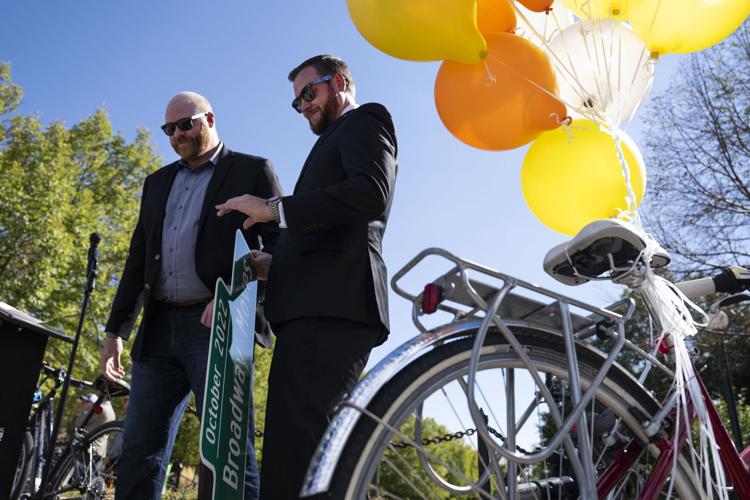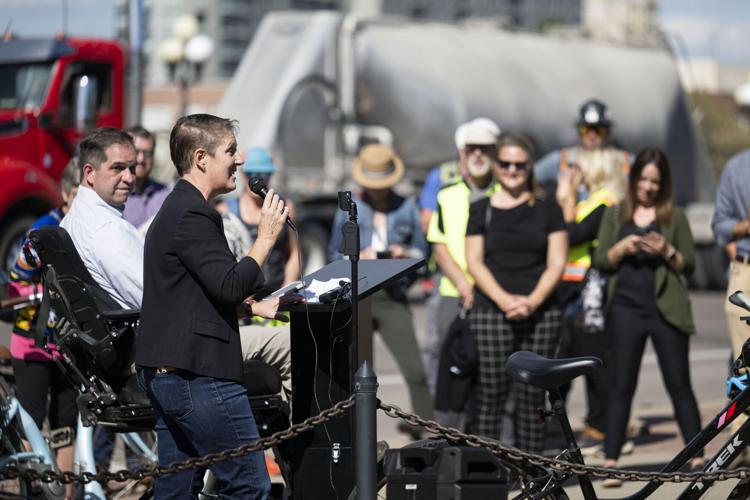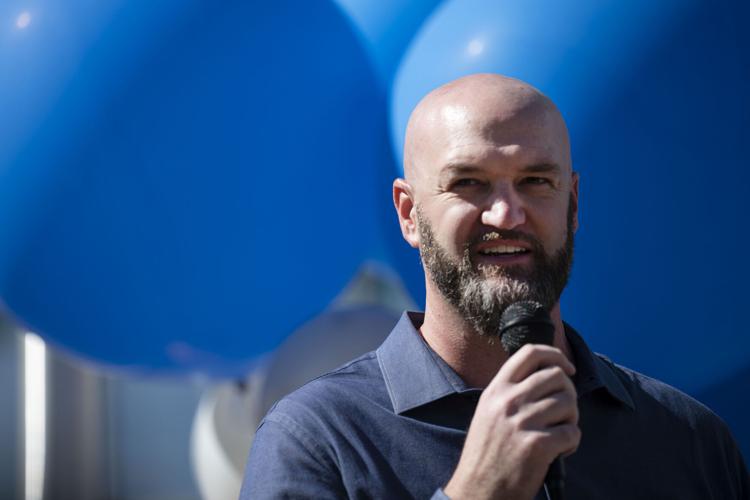Denver aims to make biking on Broadway safer in 2023

Luke Johnson, president of the Broadway Merchants Association, talks with City and County of Denver Department of Transportation & Infrastructure executive director Adam Phipps while holding a “Broadway Moves” street sign gifted to him during an event to announce the start of installation of multimodal improvements on North Broadway, from East 7th Avenue to Center Avenue, on Monday, Oct. 10, 2022, in Denver, Colo.. (Timothy Hurst/The Gazette)
TIMOTHY HURST/DENVER GAZETTE
Biking and walking along Broadway between 7th and Center avenues should be far more accessible in 12-18 months, according to City of Denver officials.
Denver’s transportation department kicked off its Broadway multimodal improvements project with a celebration. District 7 Councilman Jolon Clark said the improvements were “a long time coming.”
The program aims to improve to the corridor with safety top-of-mind. That’s for all traveling along the major north/south arterial road, pedestrians, cyclists and scooter riders included. The 1.5-mile improvement area will include a two-way, protected bike lane, upgraded traffic signals, and shortened crossing distances for pedestrians.
The Elevate Denver Bond covered much of the cost for the $14.3 million project, with a $9.6 million grant coming from the Safer Main Streets Initiative.
“This work will further our Vision Zero goal to eliminate fatal and serious injury crashes along the corridor and provide more and better options for people to access and enjoy Broadway without a car,” Adam Phipps, the executive director of Denver’s Department of Transport and Infrastructure, said. “This Broadway facility will be an important new addition to the bike network.”
Denver will also add 44 more miles of bike lanes, which will see the city exceed a five-year goal of adding 125 miles of bike lanes, he said. More than 90% of these 44 new miles will be what is known as a “high comfort” lane.
A high comfort lane has a clear buffer between people on bikes and people in cars. It can be as simple as a wide dividing line between the bike lane and street or a curb built into the road, said Nancy Kuhn, the director of communications for DOTI.
“It’s gonna be great,” Kuhn said. “People are gonna be able to come right off Cherry Creek Trail, hop on and head downtown in a protected way.”
Many families want to walk or bike along the stretch of Broadway but can’t because of how unsafe it felt, she said. The construction project will add two layers of protection for pedestrians: bike lanes and a row of parking spots for cars.
The department has high hopes for the 12-18 month improvement plan. Much of that comes from the observed success of a pilot program further down south Broadway between Bayaud and Virginia avenues.
“People liked it so much that it’s been up since 2016,” Clark said. “People said, ‘please, we know it doesn’t connect all the way, but this is so impactful for this area.'”
Initially, the pilot program had an expiration date, but it remained after the positive feedback. The new improvement plan extends the existing lane from Cherry Creek Trail to Center Avenue.
Kuhn said the impact on existing car traffic will be minimal. During the 15-month pilot period between 2016 to 2017, DOTI conducted studies that found traffic impacts due to the added parking spaces and bike lanes were “insignificant.”
Beyond pedestrian safety, adding the two-way bike path will give local businesses a step up as bikers are far more likely to stop in than car drivers.
“The research shows that people on bikes are going to stop, and they’re going to grab ice cream, they’re going to grab food for their cat on the way home,” Clark said. “They’re going to stop and shop and support our small businesses and our community in ways that these cars are never going to do.”
Luke Johnson, the president of the Broadway Merchants Association, recognizes the importance of the improvements. The Association represents over 100 small businesses that operate on Broadway.
“Broadway is one of the oldest shopping and dining districts in Denver, and for most of the last century, it’s been heavily trafficked with cars,” Johnson said. ” Today, we will welcome a new era that will save the next 100 years of this corridor.”























